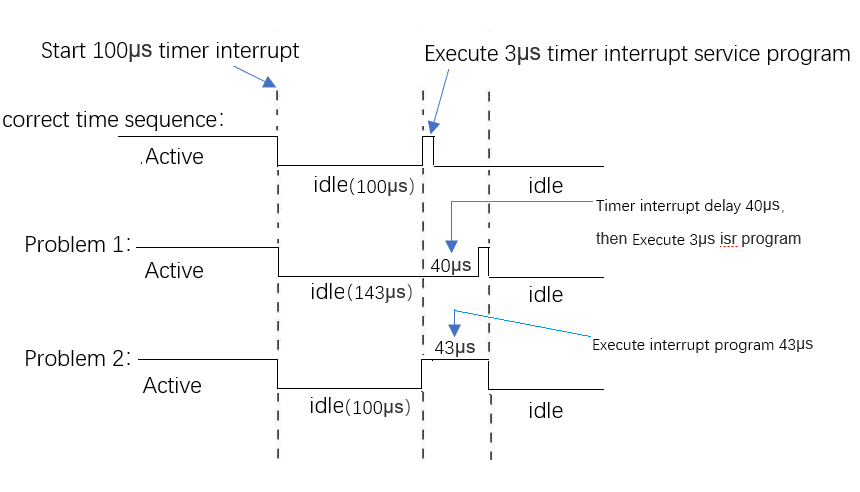Tool/software: TI-RTOS
I want to set PWM pulse width in timer interrupt (TIMERA, 125us,need high Accuracy). For power saving,CPU enter idle mode . In my application, every 120 times(15ms),CPU will run 2ms(active mode,not enter idle). So when entering or exiting active programm, the timer will be slow or quick. If it's quick, i can use CPUdelay() . If it's slow, I stop the timer,and start another timer TIMERB.
In interrupt TIMERB,I restart TIMERA
The simple programmer (not including 2ms function) is following
{
/* Call board init functions */
Board_initGeneral();
ledPinHandle = PIN_open(&ledPinState, pinTable);
if(!ledPinHandle)
{
System_abort("Error initializing board LED pins\n");
}
Timer_init();
BIOS_start();
{
/* Switches the peripheral power domain on */
Power_setDependency(PowerCC26XX_PERIPH_GPT2);
Power_setConstraint(PowerCC26XX_SB_DISALLOW);
Hwi_Params params;
Hwi_Params_init(¶ms);
params.enableInt = TRUE;
params.priority = 1;
Hwi_construct(&timerHwi, INT_GPT2A, &interruptTimerA, ¶ms, NULL);
Hwi_construct(&timerHwi, INT_GPT2B, &interruptTimerB, ¶ms, NULL);
/* Configure the timer hardware */
TimerDisable(GPT2_BASE, TIMER_A);
TimerDisable(GPT2_BASE, TIMER_B);
TimerConfigure(GPT2_BASE, TIMER_CFG_SPLIT_PAIR | TIMER_CFG_A_PERIODIC | TIMER_CFG_B_ONE_SHOT);//TIMER_CFG_B_ONE_SHOT
TimerPrescaleSet(GPT2_BASE, TIMER_A, 9); //
TimerPrescaleSet(GPT2_BASE, TIMER_B, 9);
TimerLoadSet(GPT2_BASE, TIMER_A, 600); //
TimerLoadSet(GPT2_BASE, TIMER_B, 450);
TimerIntClear(GPT2_BASE, TIMER_TIMA_TIMEOUT);
TimerIntEnable(GPT2_BASE, TIMER_TIMA_TIMEOUT);
TimerEnable(GPT2_BASE, TIMER_A);
TimerIntClear(GPT2_BASE, TIMER_TIMB_TIMEOUT);
TimerIntEnable(GPT2_BASE, TIMER_TIMB_TIMEOUT);
// TimerEnable(GPT2_BASE, TIMER_B);
{
PIN_setOutputValue(ledPinHandle, LED_IDLE,0);
HWREG(PRCM_BASE +PRCM_O_PDCTL1VIMS) &= ~PRCM_PDCTL1VIMS_ON;
PRCMCacheRetentionEnable();
PRCMPowerDomainOff(PRCM_DOMAIN_CPU);
SysCtrlAonSync();
PRCMDeepSleep();
PIN_setOutputValue(ledPinHandle, LED_IDLE,1);
}
}
{
uint32_t status = TimerIntStatus(GPT2_BASE, true);
if (TIMER_TIMA_TIMEOUT & status) {
TimerIntClear(GPT2_BASE, TIMER_TIMA_TIMEOUT);
}
PIN_setOutputValue(ledPinHandle, LED_INTA,1);
PIN_setOutputValue(ledPinHandle, LED_SET,!PIN_getOutputValue(LED_SET));
// HWREG(GPT0_BASE + TBMATCHR)= duty0[index_out*NUM_MIC_SAMPLES_PACKET+ipwm];
// HWREG(GPT0_BASE + TAMATCHR)= duty1[index_out*NUM_MIC_SAMPLES_PACKET+ipwm];
if(IdleT++>=120)
{
IdleT=0;
TimerEnable(GPT2_BASE, TIMER_B);
TimerDisable(GPT2_BASE, TIMER_A);
PIN_setOutputValue(ledPinHandle, LED_INTB,1);
}
PIN_setOutputValue(ledPinHandle, LED_INTA,0);
}
{
uint32_t status = TimerIntStatus(GPT2_BASE, true);
if (TIMER_TIMB_TIMEOUT & status) {
TimerIntClear(GPT2_BASE, TIMER_TIMB_TIMEOUT);
}
PIN_setOutputValue(ledPinHandle, LED_INTB,0);
CPUdelay(158); //adjust the time of seting pwm
PIN_setOutputValue(ledPinHandle, LED_SET,!PIN_getOutputValue(LED_SET));
// HWREG(GPT0_BASE + TBMATCHR)= duty0[index_out*NUM_MIC_SAMPLES_PACKET+ipwm];
// HWREG(GPT0_BASE + TAMATCHR)= duty1[index_out*NUM_MIC_SAMPLES_PACKET+ipwm];
CPUdelay(11);
TimerEnable(GPT2_BASE, TIMER_A);
}




